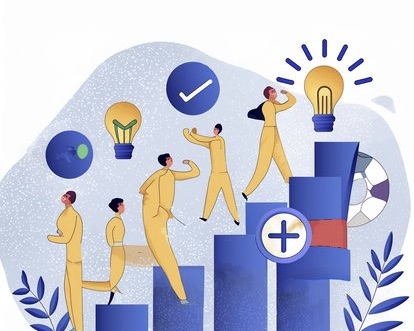The era of “gold-collar workers”

The era of “gold-collar workers” – What leadership practices are effective in collaboration with knowledge workers?
Industry 4.0 and 5.0 have not only been contributing to changes in the development of new products and services, but also affecting management and leadership, dictating new approaches to employees. What are these approaches? Which practices are most effective when collaborating with “gold-collarworkers”?
Leadership begins to take on a new shape when applied in knowledge-intensive organizations. What characterizes such organizations? M. Alvesson divided them into two groups: those involved in professional services, e.g., accounting offices, advertising agencies, law firms, and those engaged in research and development, e.g., research centers of various high-tech companies. Therefore, knowledge-intensive organizations need to rely on resources such as creativity,interdisciplinarity and innovation when it comes to both their employees and their products.
The strength of such organizations lies in their experts – knowledge workers with competencies that are often well above average. They are professionals for whom knowledge is equally a raw material, a means of production, and the result of their work. According to R.E. Kelly, “gold-collar workers” are knowledgeworkers who have a strong need for independence (or freedom) and want to feel that they’re doing something important and useful. For these specialists, the main motivation is not money, but whether they’re passionate about their work, its impact on the world and the satisfaction they can get from it.
How can we work effectively when the majority of our team consists of “gold-collar workers”? What if we lack competence in the area of their expertise? These are the questions that leaders frequently ask themselves. Below, we provide some useful tips:
- When we have various specialists in our team, we can start by reassessing or auditing the organizational culture of our company. For instance, we may need to shift from a culture of cynicism to one that’s focused on cooperation, support and encouraging teams to utilize their ideas and capabilities. However, we need to move from words to actions because the most common “sin” committed by leaders is making empty promises, which fuels the culture of cynicism.
- We should communicate and demonstrate things in a broader context, not only saying what needs to be done, but also why, how it works, what it entails, who will benefit from it, etc. For “gold-collar workers” it is fundamental for effective cooperation. Here, leaders need not only good communication skills,but highly developed ones. If they want their employees to engage in implementing their plans, they need to properly justify their decisions.
- It is also worth making sure that the employees possess the right competencies for the tasks and projects they undertake. It is crucial, since research indicates that “gold-collar workers” tend to identify more with their own work than with the organization itself. It’s also important that leaders align the individual goals and values of the experts with the goals and vision of the company. It allows them to effectively build long-term organizational commitment among employees.
- In knowledge-intensive organizations employees expect challenges and interesting tasks that will enable them to use their existing skills and develop new ones. Whenever it is possible, leaders should ensure that the experts’ knowledge is utilized in such engaging tasks.
- We also need to go back to the basics, that is, the reasons behind the employees’ long-term motivation. What values drive them every day? The knowledge of what motivates people isn’t something that can be acquired in a day. This process requires numerous, often one-on-one conversations and asking precise questions. It forces leaders to constantly practice their communication skills. Only with this knowledge can we further adjust training and development programs within the organization.
Collaborating with “gold-collar workers” is also a test for leaders to see how much they themselves want to develop in terms of communication and new approaches to management. All of the above is also influenced by economic and social factors, as well as the emotional state of both leaders and their employees. The digital revolution has generated a new group of experts who, thanks to it, can acquire knowledge more easily, quickly and effectively, thereby implementing it faster and learning from it. These types of employees may possess significantly more knowledge than others, and thus exhibit a narcissistic attitude during cooperation. However, leaders cannot succumb to this narrative.
What are the trends for the future? Technological and technical skills will continue to be diminished by AI development, while emotional intelligence and highly developed communication skills will enjoy a renaissance again. There will no longer be room for slogans and tricks, at least not in managing “gold-collar workers”.
Author: Anna Modrzewska
References:
Gadomska‑Lila, K. (2018). “Przywództwo w organizacjach wiedzochłonnych.” Edukacja Ekonomistów i Menedżerów, 47(1), 43-57.
Alvesson, M. (2004). Knowledge Work and Knowledge‐Intensive Firms. Oxford: Oxford University Press.
Newell, S., Robertson, M., Scarbrough, H., Swan, J. (2002). Managing Knowledge Work. New York: Palgrave.
Kelley, R.E. (1985). The Gold Collar Worker: Harnessing the Brainpower of the New Workforce. Reading, MA: Addison‐Wesley.